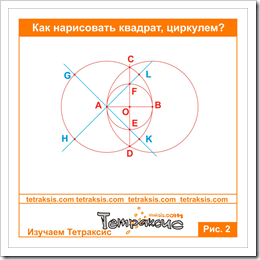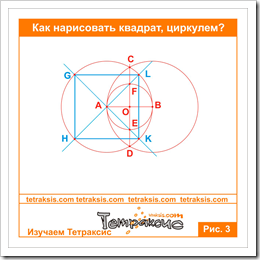You can easily enter a square into a circle using drawing tools. But this problem is solved even with their complete absence. It is only necessary to remember some properties of the square.
You will need
- -compass
- -pencil
- -gon
- -scissors
Instruction manual
Draw a sketch for the task. Obviously, the diameter of the circle is the diagonal of the square inscribed in this circle. Remember the well-known property of a square: its diagonals are mutually perpendicular. Use this diagonal relationship when constructing a given square.
Draw a diameter in a circle. From the center, use a square to draw the second diameter at an angle of 90 degrees to the first. Connect the intersection points of the perpendicular diameters with the circle and get a square inscribed in this circle.
If you only have compasses from drawing instruments, draw a circle. Mark an arbitrary point on the circle and draw a diameter through it using any object with a smooth edge. Now you need to use a compass to divide half the circle between the ends of the diameter into two equal parts. From the points of intersection of the diameter with the circle, make two notches, keeping the compass solution unchanged. Draw a second diameter through the intersection point of these serifs and the center of the circle. Obviously, it will be perpendicular to the first.
If you don’t have any drawing tools, you can use a pair of scissors to cut out a circle from paper, limited by a given circle. Fold the cut shape exactly in half. Repeat the operation. It is necessary to combine the ends of the fold line, then the curved sections coincide without additional effort. Lock the addition lines. Now expand the circle. The fold lines are clearly visible. Fold the segments of the circle between the intersection points of the fold lines with the circle and cut off these segments. Cut lines are sides of the desired square. Place the cut square in the given circle, aligning its center with the intersection point of the fold lines of the circle. The vertices of the square will be lying on the circle, which was required to be performed.
You can easily enter a square into a circle using drawing tools. But this problem is solved even with their complete absence. It is only necessary to remember some properties of the square.
You will need
- -compass
- -pencil
- -gon
- -scissors
Instruction manual
Draw a sketch for the task. Obviously, the diameter of the circle is the diagonal of the square inscribed in this circle. Remember the well-known property of a square: its diagonals are mutually perpendicular. Use this diagonal relationship when constructing a given square.
Draw a diameter in a circle. From the center, use a square to draw the second diameter at an angle of 90 degrees to the first. Connect the intersection points of the perpendicular diameters with the circle and get a square inscribed in this circle.
If you only have compasses from drawing instruments, draw a circle. Mark an arbitrary point on the circle and draw a diameter through it using any object with a smooth edge. Now you need to use a compass to divide half the circle between the ends of the diameter into two equal parts. From the points of intersection of the diameter with the circle, make two notches, keeping the compass solution unchanged. Draw a second diameter through the intersection point of these serifs and the center of the circle. Obviously, it will be perpendicular to the first.
If you don’t have any drawing tools, you can use a pair of scissors to cut out a circle from paper, limited by a given circle. Fold the cut shape exactly in half. Repeat the operation. It is necessary to combine the ends of the fold line, then the curved sections coincide without additional effort. Lock the addition lines. Now expand the circle. The fold lines are clearly visible. Fold the segments of the circle between the intersection points of the fold lines with the circle and cut off these segments. Cut lines are sides of the desired square. Place the cut square in the given circle, aligning its center with the intersection point of the fold lines of the circle. The vertices of the square will be lying on the circle, which was required to be performed.
Attention, only TODAY!
All interesting
A circle is a closed curve line, all points of which are equally spaced from one point. This point is the center of the circle, and the segment between the point on the curve and its center is called the radius of the circle. Instruction 1: If through the center ...
A circle is called inscribed in a polygon if it is completely placed inside this polygon. Each side of the described figure has a circle common point. You will need a compass-pencil-ruler-sheet of paperInstruction 1For ...
Division of a circle into five equal parts - A fairly simple procedure with knowledge of some tricks that allow you to do this flawlessly accurately. It is very easy to cope with this task, armed with a pair of compasses or a protractor. You…
By definition, if all the vertices of a polygon belong to a circle, it is called “inscribed." To build such a figure on paper is not difficult, especially if all its component parts have the same length. For the right ...
When conducting constructions of various geometric figures, sometimes it is necessary to determine their characteristics: length, width, height, and so on. If we are talking about a circle or circle, it is often necessary to determine their diameter. The diameter is ...
The task of fitting a polygon into a circle can often lead an adult to a standstill. A child-student needs to explain her decision, so parents go surfing the World Wide Web in search of a solution. Instruction ...
Dividing a circle into several equal parts is a common task. So you can build a regular polygon, draw a star or prepare the basis for the scheme. There are several ways to solve this interesting problem. You will need-…
A polygon is called inscribed if all its vertices lie on a circle. Any regular polygon can be inscribed in a circle, including one with five sides. In classic drawing, this requires some additional ...
Representatives of various professions are constantly confronted with the construction of inscribed and described polygons. Usually triangles do not cause any problems, since any figure of this type can be inscribed in a circle. Quadrangles deal ...
The circumference of a circle cannot be accurately measured with a ruler, and therefore dividing it into equal parts is not an easy task, especially if there are an odd number of these parts. The division of the circle into five parts is carried out using a conventional compass or ...
Being an integral part of the school curriculum, geometric problems to build regular polygons quite trivial. As a rule, the construction is carried out by inscribing the polygon into a circle, which is drawn ...
This article will tell you how to draw a square using “Vesica Piscis”. In principle, the method is so simple that it might not be worth it to devote a separate article to it, but the integrity of the presentation does not imply spaces, and therefore, if you please ...
So, to build a square inscribed in a circle, we build a “Vesica Piscis” (Fig. 1).
1. We build perpendiculars “Vesica Piscis” AB and CD (Fig. 1). A and B are the centers of the original circles, C and D are the points of their intersection. We mark the point of intersection of the perpendiculars AB and CD, point O.
2. Build a circle inscribed in “Vesica Piscis”, centered at point O and with a radius equal to half the radius of any of the original circles, for example AO.
3. Mark the points of intersection of the perpendicular CD and the inscribed circle (with center O, radius AO), points F and E.

4. Draw direct AF and AE (Fig. 2).
5. Mark the points of intersection of the straight lines AF, AE with the original circle (with center A, radius AB), points G, H, K, L.

6. Draw the lines GL, LK, KH, HG (Fig. 3).
7. The square GHKL inscribed in the original circle (with center A, radius AB) is built.
Probably not at all superfluous, it will be recalled the basic properties of the square.
So.
1. The sides, the square, are equal.
2. Inside corners, squares, straight lines (90 0).
3. Diagonals, squares, are equal.
4. Diagonals, squares, are the bisectors of its angles.
5. Diagonals, squares, are perpendicular to each other.
6. Diagonals, squares, divide each other in half.
7. The centers of the inscribed and described squares coincide with the center of the corresponding circle.
8. The diagonals of the inscribed or described squares divide the circle into four equal parts.
Well, perhaps that's all ...


